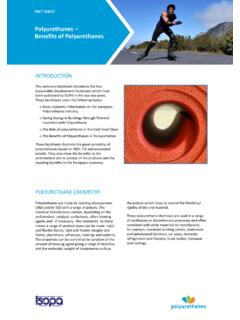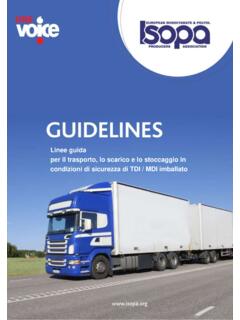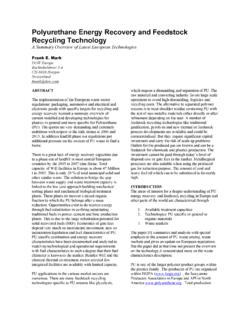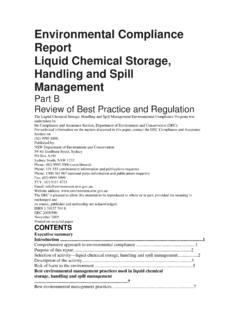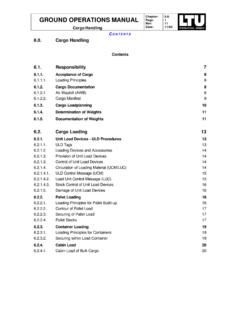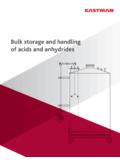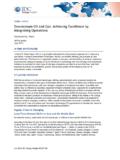Transcription of GuidelineS - ISOPA
1 GuidelineS 13rd Revision - March Safe loading / unloading Transportation Storage of Tdi and Mdi in BulkGuidelineS 23rd Revision - March 2011 ForewordThe second revision of these GuidelineS , dated February 2006, has been thoroughly reviewed by ISOPA s Logistics EHS Working Group under chairmanship of H. van Wijnen (Huntsman).The intention is to contribute to overall safety standards by updating these GuidelineS and adding numerous topics to address the comments received and experience gained over the past 4 note that asterisks (*) have not been used to indicate updates because there are a lot of changes. Indeed, this third revision should be regarded as a complete would particularly like to thank my colleagues in the Working Group for their commitment and co-operation:S. Beddegenoodts - DowR. Magliocchi - ShellN.
2 Meijboom - ShellR. Vieler - BayerH. van WijnenChairmanGuidelineS 33rd Revision - March 2011 Preface to the Third RevisionThe main changes contained in this third revision are as follows:Removal of data from Chapter 2 that can be easily found on the producer s Safety Data Sheet, classification and labelling, hazard statements, signal words, transport classification. Removal of chapters on Transport by Rail and Transport by Sea or Inland Water. Addition of a chapter on Storage. Addition of sections within chapters on: Non Standard Operations (NSO) TDI / MDI and Polyol in adjacent compartments 80/20 rule Fall protection Complete review and edit of other content including rephrasing for: Fall protection Markings for vapour, liquid and pressure connection Sample tube Sizing of vapour return hose Opening of tank containers and the Do not open the manlid stickerAn appendix is added describing the chemistry of the reaction of isocyanates with water.
3 GuidelineS 43rd Revision - March 2011 ContentsForeword 2 Preface to the Third Revision 31 Introduction Purpose Products Scope Transport Safety Adoption 82 Main Properties, Hazards and Safety Information Appearance TDI Polymeric MDI Monomeric MDI Main Physical / Chemical Hazards Health Hazards and First Aid 103 Personal Protective Equipment Recommended Personal Protective Equipment 12 Transfer TDI Recommended Personal Protective Equipment 12 to Transfer MDI Emergency Equipment 124 Design and Construction of bulk Transport Equipment bulk Transport Equipment Top Fill and Top Discharge Road Tankers, Isotanks and Swap Bodies Fall Protection Road Tankers and Isotanks Equipment Couplings, Openings and Ancillary Equipment Pressure Relief and Vacuum Valves Pressure Relief Valves - Road Tankers Pressure Relief Valves - Tank containers Vacuum Relief Valves Transport Equipment Humidity Conditions Thawing and Heating Systems Sample Tubes 17 GuidelineS 53rd Revision - March 20115 Safety Auditing of Road Carriers and Tank Operators Carrier Capability.
4 Assessment and Control Safety and Quality Assessment System Meeting Safety and Regulatory Standards 186 Training for Drivers Specific Requirements for TDI / MDI General Product Information Loading / Transport / Unloading Recommendations Technical Proficiency Spillages Minor Spillages Major Spillages Liquid Decontaminant Solutions Fire Emergency Response 227 Loading Operations Compliance with Modal Transport Regulations Availability of Written Operating Instructions 80/20 Rule Loading TDI / MDI with Polyol in Adjacent Compartments Inspection of bulk Transport Equipment Routine Inspection of Road Tankers and Tank containers 24 at Loading Initial Inspection of Road Tankers, Tank containers & 26 Swap-body Maintenance of Transport Equipment 268 Road and Intermodal Transport Carrier Responsibilities Instructions in Writing - only for TDI Routing Safe Parking Severe Weather Conditions Delays or Accidents Temperature Checks during the Journey Multi-Modal Movements Opening Tank Containers Reintroduction of Equipment to Service 29 GuidelineS 63rd Revision - March 20119 Unloading Operations Responsibilities According to the Provisions of the Seveso Directive Criteria for Discharge Facilities Safety Assessment for Unloading and Storage Facilities Criteria for Discharge Hoses Operator Protective Equipment Recommended Procedures for Unloading of bulk Equipment Non Standard Operations (NSO)
5 Direct Discharge from bulk Equipment into IBC s or Drums Unloading into more than one Storage Tank or incomplete Unloading Insufficient Capacity of Storage Tank 3810 Storage Operations Tank size Bunding Inlet Gas Venting Level Indicator and ALarm Pressure/Vacuum Protection Temperature Control Circulation 4011 ISOPA s Mutual Aid Scheme for Providing Assistance at Transport / 41 Unloading Purpose and Scope Preparedness and Emergency Advice Requirements Contractual Liabilities Technical Communication Use of the Mutual Aid Scheme 43 Appendix 1: Reaction of Diisocyanates with Water 44 GuidelineS 73rd Revision - March 20111 PurposeThese GuidelineS have been prepared by ISOPA (the European Diisocyanate & Polyol Producers Association), a sector group of CEFIC (the European Chemical Industry Federation), to establish appropriately high levels of safety for the loading / unloading, transportation and storage of toluene diisocyanate (TDI) and diphenylmethane diisocyanate (MDI).
6 Whilst MDI is classified and regulated as hazardous only for use and TDI as hazardous for both use and transport, they can be handled and shipped safely provided that appropriate precautions are ProductsReference is made throughout these GuidelineS to TDI and MDI and to their variants and preparations to the extent that products are classified as TDI and MDI. Preparations containing solvents are not covered by this decision of the UN Committee acknowledges that MDI does not meet hazard conditions for inclusion in Hazard Class However, MDI quite properly continues to be regulated in EU countries as a hazardous material in handling and usage (see Chapter 2). For this reason, it has been decided to continue to treat MDI in these GuidelineS . To avoid the need for repeated explanations in the text of the GuidelineS , wherever MDI is referred to as a hazardous material it should be understood in this ScopeThese GuidelineS cover important aspects of loading, unloading, transportation and storage activities of TDI and MDI in bulk from loading to delivery point.
7 They deal with bulk transport units such as road tankers, isotanks and swap-body containers. Reference to existing regulatory controls is only made where this is considered necessary for the purpose of GuidelineS do not deal with the bulk movement of TDI / MDI in ocean-going chemical tankers, inland waterway barges and rail tank Transport SafetyIt is strongly recommended that TDI and MDI producers arrange transport with approved carriers ( SQAS assessed or similar system).All carriers should train their drivers who transport TDI and / or MDI using the ISOPA driver training package ( / logistics eHS / driver training).Customer collection of TDI / MDI is not advised. If unavoidable then only carriers participating in the ISOPA driver training program should be 83rd Revision - March AdoptionISOPA recommends these GuidelineS to be adopted by all parties who are involved in the transport and distribution of TDI / is the individual responsibility of users of these GuidelineS to evaluate and apply them taking all specific circumstances and their own situation into part of these GuidelineS may be used or interpreted in a way that conflicts with existing international and / or national legislation.
8 In all circumstances, applicable regulatory and legal provisions will always take precedence over these GuidelineS or any part thereof. GuidelineS 93rd Revision - March 20112 Main Properties, Hazards and Safety information (For more details see the producers Safety Data Sheets)In practice, TDI is sold as 100% 2,4-isomer or as 80/20 or 65/35 mixtures of the 2,4-and 2,6-isomers, and MDI in both its monomeric and polymeric forms. Variants and preparations of TDI and MDI are also TDIL iquidReactedTDIC lear to pale yellowsharp, pungentWhite, Polymeric MDIL iquidReactedMDIB rown,slightly mustyBrown, Monomeric MDIL iquidReactedMDIC lear to pale yellowsharp, pungentWhite,foamyGuidelineS 103rd Revision - March Main Physical / Chemical HazardsTDI / MDI are NOT inherently explosive, nor are they oxidisers, or spontaneously flammable in air or flammable at ambient temperature (note the flash points).
9 However, the following points must be noted:WaterTDI / MDI react with water to produce carbon dioxide and a biologically and chemically inert solid, known as a polyurea. While this is not in itself a dangerous reaction, it can lead to the development of excessive pressure inside closed containers. Eventually, this may even burst the tank container shell should the TDI / MDI be contaminated with water. If no corrective action is taken the reaction will become more violent. The chemistry of the reaction of isocyanates with water is described in Appendix 1. The reaction with water is accelerated by other chemicals as described chemicalsThe contamination of TDI / MDI with other chemicals must be avoided at all times!TDI / MDI react with other chemicals such as acids, alcohols, alkaline materials ( caustic soda, ammonia), and other chemicals that contain reactive groups.
10 The reaction may generate heat resulting in an increased evolution of TDI / MDI vapour and the formation of carbon dioxide. Rubber and plasticsTDI / MDI will attack and embrittle many plastics and rubber materials within a short period. Although this is not dangerous in itself, it may lead to cracking, for example of hoses and protective clothing. Particular care should be taken to ensure that your liquid tight gloves (see section ) do not contain any cracks caused by TDI / MDI a fireTDI and MDI have high flash points. However, in a fire - if heated up enough to generate sufficient vapour for ignition - they will burn, giving off volatile substances, which are hazardous if / MDI in a closed container exposed to the heat of a fire will decompose with a build-up of pressure resulting in the risk of the container Health Hazards and First AidChemicals can present a health hazard by inhalation, skin / eye contact or by swallowing.

